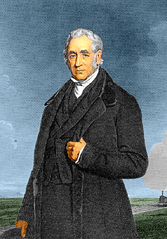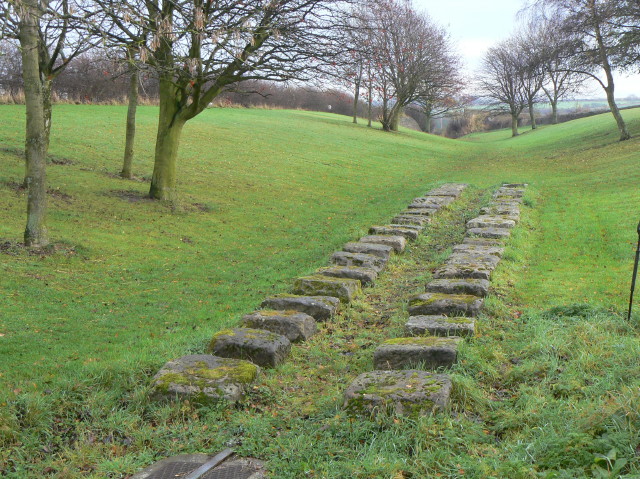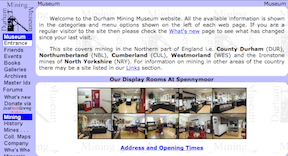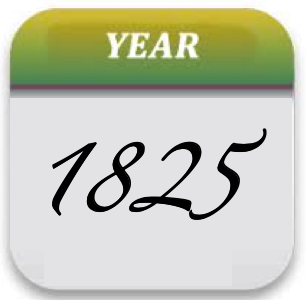Topics > Transport and Travel > Railway > Stockton and Darlington Railway
Stockton and Darlington Railway
The Stockton and Darlington Railway was the world's first public railway to use steam locomotives. The railway was primarily built to transport coal from collieries around Shildon, West Auckland and Witton Park, to the River Tees at Stockton to load onto ships to take the coal to the South of England. The opening ceremony on 27th September 1825 involved George Stephenson and others from the company making an experimental journey between Shildon and Darlington. The passengers travelled in a coach, named 'Experiment', pulled by the steam engine 'Locomotion No. 1'. The Stockton and Darlington Railway company operated from 1825 to 1863, after which it was taken over by the North Eastern Railway.
Origins
Coal from the inland mines in County Durham was taken away on packhorses, and then horse and carts as the roads were improved. A canal was proposed by George Dixon in 1767 and again by John Rennie in 1815, but both schemes failed. A few years later a canal was proposed on a route that bypassed Darlington and Yarm, and a meeting was held in Yarm to oppose the route. The Welsh engineer George Overton was consulted, and he advised building a tramroad. Overton carried out a survey and planned a route from the Etherley and Witton Collieries to Shildon, and then passing to the north of Darlington to reach Stockton. The Scottish engineer Robert Stevenson was said to favour the railway, and the Quaker Edward Pease supported it at a public meeting in Darlington on 13 November 1818, promising a five per cent return on investment. Approximately two-thirds of the shares were sold locally, and the rest were bought by Quakers nationally. A private bill was presented to Parliament in March 1819, but as the route passed through Earl of Eldon's estate and one of the Earl of Darlington's fox covers, it was opposed and defeated by 13 votes.
Overton surveyed a new line that avoided Darlington's estate and agreement was reached with Eldon, but another application was deferred early in 1820, as the death of King George III had made it unlikely a bill would pass that parliamentary year. The promoters lodged a bill on 30 September 1820, the route having changed again as agreement had not been reached with Viscount Barrington about the line passing over his land. The railway was unopposed this time, but the bill nearly failed to enter the committee stage as the required four-fifths of shares had not been sold. Pease subscribed £7,000; from that time he had considerable influence over the railway and it became known as "the Quaker line". The Act that received royal assent on 19 April 1821 allowed for a railway that could be used by anyone with suitably built vehicles on payment of a toll, that was closed at night, and with which land owners within could build branches and make junctions; no mention was made of steam locomotives. This new railway initiated the construction of more railway lines, causing significant developments in railway mapping and cartography, iron and steel manufacturing, as well as in any industries requiring more efficient transportation.
George Stephenson
Concerned about Overton's competence, Pease asked George Stephenson, an experienced enginewright of the collieries of Killingworth, to meet him in Darlington. On 12 May 1821 the shareholders appointed Thomas Meynell as Chairman and Jonathan Backhouse as treasurer; a majority of the managing committee, which included Thomas Richardson, Edward Pease and his son Joseph Pease, were Quakers. The committee designed a seal, showing waggons being pulled by a horse, and adopted the Latin motto la ("At private risk for public service"). By 23 July 1821 it had decided that the line would be a railway with edge rails, rather than a plateway, and appointed Stephenson to make a fresh survey of the line. Stephenson recommended using malleable iron rails, even though he owned a share of the patent for the alternative cast iron rails, and both types were used. Stephenson was assisted by his 18-year-old son Robert during the survey, and by the end of 1821 had reported that a usable line could be built within the bounds of the Act, but another route would be shorter by and avoid deep cuttings and tunnels. Overton had kept himself available, but had no further involvement and the shareholders elected Stephenson Engineer on 22 January 1822, with a salary of £660 per year. On 23 May 1822 a ceremony at Stockton celebrated the laying of the first track, the rails apart, the same gauge used by Stephenson on his Killingworth Railway.
Stephenson advocated the use of steam locomotives on the line. Pease visited Killingworth in mid-1822 and the directors visited Hetton colliery railway, on which Stephenson had introduced steam locomotives. A new bill was presented, requesting Stephenson's deviations from the original route and the use of "loco-motives or moveable engines", and this received assent on 23 May 1823. The line included embankments up to high, and Stephenson designed an iron truss bridge to cross the River Gaunless. The stone bridge over the River Skerne was designed by the Durham architect Ignatius Bonomi.
In 1823 Stephenson and Pease opened Robert Stephenson and Company, a locomotive works at Forth Street, Newcastle, from which the following year the S&DR ordered two steam locomotives and two stationary engines. On 16 September 1825, with the stationary engines in place, the first locomotive, Locomotion No. 1, left the works, and the following day it was advertised that the railway would open on 27 September 1825.
Opening
The cost of building the railway had greatly exceeded the estimates. By September 1825 the company had borrowed £60,000 in short-term loans and needed to earn some income. A railway coach, named Experiment, arrived the evening of 26 September 1825, was attached to Locomotion No. 1, and Pease, Stephenson and other members of the committee made an experimental journey between Shildon and Darlington, with James Stephenson, George's elder brother, at the controls. On 27 September, between 7 am and 8 am, 12 waggons of coal were drawn up Etherley North Bank by a rope attached to the stationary engine at the top, and then let down the South Bank to St Helen's Auckland. A waggon of flour bags was attached and horses hauled the train to the bottom of Brusselton West Bank, where thousands watched the second stationary engine draw the train up the incline. The train was let down the East Bank to Shildon Lane End, where Locomotion No. 1, Experiment and 21 new coal waggons fitted with seats were waiting.
The directors had allowed room for 300 passengers, but the train left carrying between 450 and 600 people, most travelling in empty waggons but some on top of waggons full of coal. Brakesmen were placed between the waggons, and the train set off, led by a man on horseback with a flag. It picked up speed on the gentle downward slope and reached , leaving behind men on field hunters (horses) who had tried to keep up with the procession. The train stopped when the waggon carrying the company surveyors and engineers lost a wheel; the waggon was left behind and the train continued. The train stopped again, this time for 35 minutes to repair the locomotive and the train set off again, reaching before it was welcomed by an estimated 10,000 people as it came to a stop at the Darlington branch junction. Eight and a half miles () had been covered in two hours, and subtracting the 55 minutes accounted by the two stops, it had travelled at an average speed of . Six waggons of coal were distributed to the poor, workers stopped for refreshments and many of the passengers from Brusselton alighted at Darlington, to be replaced by others.
Two waggons for the Yarm Band were attached, and at 12:30 pm the locomotive started for Stockton, now hauling 31 vehicles with 550 passengers. On the of nearly level track east of Darlington the train struggled to reach more than . Crowds waited for the train to cross the Stockton to Yarm turnpike. Approaching Stockton it gained speed and reached again, before a man clinging to the outside of a waggon fell off and his foot was crushed by the following vehicle. The train arrived 3 hours, 7 minutes after leaving Darlington. The opening ceremony was considered a success and that evening 102 people sat down to a celebratory dinner at the Town Hall.
Early operations
The railway that opened in September 1825 was long and ran from Phoenix Pit, Old Etherley Colliery, to Cottage Row, Stockton; there was also a half-mile (0.8 km) branch to the depot at Darlington, of the Hagger Leases branch, and a branch to Yarm. Most of the track used malleable iron rails, and of cast iron rails were used for junctions. The line was single track with four passing loops each mile; square sleepers supported each rail separately so that horses could walk between them. Stone was used for the sleepers to the west of Darlington and oak to the east; Stephenson would have preferred all of them to have been stone, but the transport cost was too high as they were quarried in the Auckland area. The railway opened with the company owing money and unable to raise further loans; Pease advanced money twice early in 1826 so the workers could be paid. By August 1827 the company had paid its debts and was able to raise more money; that month the Black Boy branch opened and construction began on the Croft and Hagger Leases branches. During 1827 shares rose from £120 at the start to £160 at the end.
Initially the line was used to carry coal to Darlington and Stockton, carrying 10,000 tons in the first three months and earning nearly £2,000. In Stockton the price of coal dropped from 18 to 12 shillings, and by the beginning of 1827 was 8 shillings 6 pence (8s 6d). Initially the drivers had been paid a daily wage, but after February 1826 they were paid d per ton per mile; from this they had to pay assistants and fireman and to buy coal for the locomotive. The 1821 Act had received opposition from the owners of collieries on the River Wear who supplied London and feared competition, and it had been necessary to restrict the rate for transporting coal destined for ships to d per ton per mile, which had been assumed would make the business uneconomic. There was interest from London for 100,000 tons a year, so the company began investigations in September 1825. In January 1826 the first staith opened at Stockton, designed so waggons over a ship's hold could discharge coal from the bottom. A little over 18,500 tons of coal was transported to ships in the year ending June 1827 and this increased to over 52,000 tons the following year, per cent of the total carried.
The locomotives were unreliable at first. Soon after opening Locomotion No. 1 broke a wheel, and it was not ready for traffic until 12 or 13 October; Hope, the second locomotive, arrived in November 1825 but needed a week to ready it for the line – the cast-iron wheels were a source of trouble. Two more locomotives of a similar design arrived in 1826; that August 16s 9d was spent on ale to motivate the men maintaining the engines. By the end of 1827 the company had also bought Chittaprat from Robert Wilson and Experiment from Stephenson. Timothy Hackworth, locomotive superintendent, used the boiler from the unsuccessful Chittaprat to build the Royal George in the works at Shildon; it started work at the end of November. John Wesley Hackworth later published an account stating that locomotives would have been abandoned were it not for the fact that Pease and Thomas Richardson were partners with Stephenson in the Newcastle works, and that when Timothy Hackworth was commissioned to rebuild Chittaprat it was "as a last experiment" to "make an engine in his own way". Both Tomlinson and Rolt state this claim was unfounded and the company had shown earlier that locomotives were superior to horses, Tomlinson showing that coal was being moved using locomotives at half the cost of horses. Robert Young states that the company was unsure as to the real costs as they reported to shareholders in 1828 that the saving using locomotives was 30 per cent. Young also showed that Pease and Richardson were both concerned about their investment in the Newcastle works and Pease unsuccessfully tried to sell his share to George Stephenson.
New locomotives were ordered from Stephenson's, but the first was too heavy when it arrived in February 1828. It was rebuilt with six wheels and hailed as a great improvement, Hackworth being told to convert the remaining locomotives as soon as possible. In 1828 two locomotive boilers exploded within four months, both killing the driver and both due to the safety valves being left fixed down while the engine was stationary. Horses were also used on the line, and they could haul up to four waggons. The dandy cart was introduced in mid-1828: a small cart at the end of the train, this carried the horse downhill, allowing it to rest and the train to run at higher speed. The S&DR made their use compulsory from November 1828.
Passenger traffic started on 10 October 1825, after the required licence was purchased, using the Experiment coach hauled by a horse. The coach was initially timetabled to travel from Stockton to Darlington in two hours, with a fare of 1s, and made a return journey four days a week and a one-way journey on Tuesdays and Saturdays. In April 1826 the operation of the coach was contracted for £200 a year; by then the timetabled journey time had been reduced to hours and passengers were allowed to travel on the outside for 9d. A more comfortable coach, Express, started the same month and charged 1s 6d for travel inside. Innkeepers began running coaches, two to Shildon from July, and the Union, which served the Yarm branch from 16 October. There were no stations: in Darlington the coaches picked up passengers near the north road crossing, whereas in Stockton they picked up at different places on the quay. Between 30,000 and 40,000 passengers were carried between July 1826 and June 1827.
Visit the page: Stockton and Darlington Railway for references and further details. You can contribute to this article on Wikipedia.

from http://books.google.co.uk/boo…
The History of the Stockton and Darlington Railway and Its Various Branches. George Markham Tweddell, 1869
- Digitised book from 1869 available as a free Google eBook.
Added by
Simon Cotterill

from Beamish (flickr)
Filming at Beamish Museum - BBC History of the World
Pinned by Simon Cotterill

from Beamish (flickr)
Filming at Beamish Museum - BBC History of the World
Pinned by Simon Cotterill

from Flickr (flickr)
Stockton and Darlington Railway 0-6-0 No. 25 'Derwent' - Darlington Railway Museum
Pinned by Simon Cotterill

from Flickr (flickr)
North Road Passenger Station - Darlington Railway Museum
Pinned by Simon Cotterill

from Flickr (flickr)
Stone block sleepers, Stockton and Darlington Railway
Pinned by Simon Cotterill

from Flickr (flickr)
Stockton and Darlington, Weardale and Redcar Railways timetable 1847
Pinned by Simon Cotterill

from Flickr (flickr)
World's first railway ticket office, St. Johns Crossing, Stockton on Tees
Pinned by Simon Cotterill

from http://upload.wikimedia.org/w…
Stockton and Darlington seal
- Image from Tomlinson, William Weaver, 1858-1916 (1915). The North Eastern Railway; its rise and development. Source Wikimedia Commons. Public domain.
Added by
Simon Cotterill

Co-Curate Page
Locomotion - Railway Museum at Shildon
- Overview About the Museum Map Street View Locomotion is a railway museum located in Shildon, County Durham. Shildon was a major railway centre and was the location of Timothy Hackworth's …

from Flickr (flickr)
Stockton & Darlington Railway 0-4-0 No. 1 'Locomotion' (1825) Head of Steam, Darlington 30.06.2009 P6300109
Pinned by Simon Cotterill

Co-Curate Page
George Stephenson (1781 - 1848)
- Overview Detailed Information George Stephenson was a famous engineer and inventor, considered to be "father of the railways". He was born in Wylam in Northumberland on 9th June 1781. In 1814, Stephenson …

from https://commons.wikimedia.org…
Croft Spa railway station in Hurworth Place, c1908
- "...In 1829 the Croft branch line was built by the Stockton and Darlington Railway Company from Darlington to Croft terminus on the north bank of the Tees in Hurworth Place. …
Added by
Simon Cotterill

from Flickr (flickr)
Hopetown Carriage Works seen from main entrance side, Darlington 30.06.2009 P6300106
Pinned by Simon Cotterill

Co-Curate Page
Central Railway Station
- Overview About the Station Map Street View The Central Railway Station in Redcar was built c.1861 for the coastguard extension of the Stockton and Darlington Railway. The station is a …

from Geograph (geograph)
Commemorative plaque on former booking-hall of S&D Railway, Stockton
Pinned by Simon Cotterill

Co-Curate Page
Brusselton Incline
- The Brusselton Incline was part of the route of the Stockton and Darlington Railway.


from http://books.google.co.uk/boo…
The History of the Stockton and Darlington Railway and Its Various Branches. George Markham Tweddell, 1869
- Digitised book from 1869 available as a free Google eBook.
Added by
Simon Cotterill

from Beamish (flickr)
Filming at Beamish Museum - BBC History of the World
Pinned by Simon Cotterill

from Beamish (flickr)
Filming at Beamish Museum - BBC History of the World
Pinned by Simon Cotterill

from Flickr (flickr)
Stockton and Darlington Railway 0-6-0 No. 25 'Derwent' - Darlington Railway Museum
Pinned by Simon Cotterill

from Flickr (flickr)
North Road Passenger Station - Darlington Railway Museum
Pinned by Simon Cotterill

from Flickr (flickr)
Stone block sleepers, Stockton and Darlington Railway
Pinned by Simon Cotterill

from Flickr (flickr)
Stockton and Darlington, Weardale and Redcar Railways timetable 1847
Pinned by Simon Cotterill

from Flickr (flickr)
World's first railway ticket office, St. Johns Crossing, Stockton on Tees
Pinned by Simon Cotterill

from http://upload.wikimedia.org/w…
Stockton and Darlington seal
- Image from Tomlinson, William Weaver, 1858-1916 (1915). The North Eastern Railway; its rise and development. Source Wikimedia Commons. Public domain.
Added by
Simon Cotterill

Co-Curate Page
Locomotion - Railway Museum at Shildon
- Overview About the Museum Map Street View Locomotion is a railway museum located in Shildon, County Durham. Shildon was a major railway centre and was the location of Timothy Hackworth's …

from Flickr (flickr)
Stockton & Darlington Railway 0-4-0 No. 1 'Locomotion' (1825) Head of Steam, Darlington 30.06.2009 P6300109
Pinned by Simon Cotterill

Co-Curate Page
George Stephenson (1781 - 1848)
- Overview Detailed Information George Stephenson was a famous engineer and inventor, considered to be "father of the railways". He was born in Wylam in Northumberland on 9th June 1781. In 1814, Stephenson …

from https://commons.wikimedia.org…
Croft Spa railway station in Hurworth Place, c1908
- "...In 1829 the Croft branch line was built by the Stockton and Darlington Railway Company from Darlington to Croft terminus on the north bank of the Tees in Hurworth Place. …
Added by
Simon Cotterill

from Flickr (flickr)
Hopetown Carriage Works seen from main entrance side, Darlington 30.06.2009 P6300106
Pinned by Simon Cotterill

Co-Curate Page
Central Railway Station
- Overview About the Station Map Street View The Central Railway Station in Redcar was built c.1861 for the coastguard extension of the Stockton and Darlington Railway. The station is a …

from Geograph (geograph)
Commemorative plaque on former booking-hall of S&D Railway, Stockton
Pinned by Simon Cotterill






































